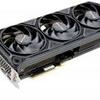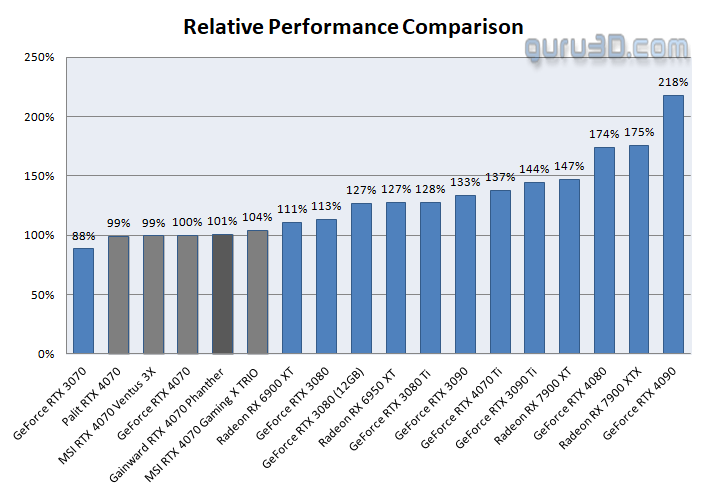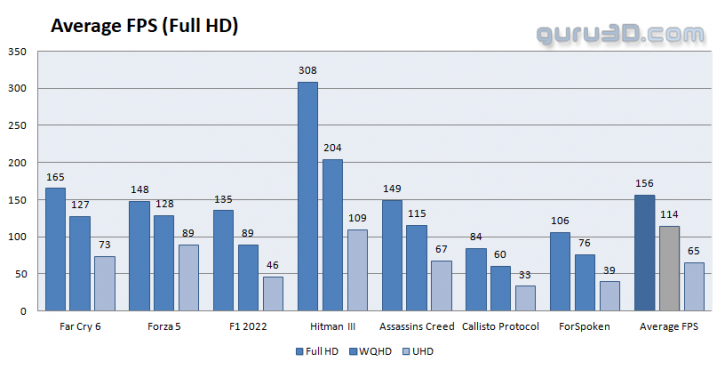Final words and conclusion
Final words
Equipped with a triple-slot, triple-fan cooling system, the Panther cards feature a black shroud adorned with functional, visually appealing indents and patterns. The intelligent flow-through design contributes to efficient temperature management. These cards also include a large heatsink connected to an extensive copper base, covering both the GPU and memory components. A protective plate is provided to prevent the card from sagging. Although the Gainward Panther Edition may not greatly surpass reference/founder performance, a modest $50 premium over the reference MSRP could be justified. Admittedly, the founder edition card is a strong contender. However, with a straightforward manual tweak, users can effortlessly obtain an extra 5% performance boost from the Panther card. NVIDIA has released the GeForce RTX 4070, the latest addition to the ADA product line. With its more affordable price point, this graphics card is now within reach for many end-users. Although NVIDIA heavily promotes the DLSS technology as a game-changer, we hope they won't overlook the importance of raw rasterizer shader performance in future products. The GeForce RTX 4070 boasts a powerful architecture, advanced ray tracing capabilities, and enhanced DLSS technology, significantly improving its performance over its predecessors. However, its performance can fluctuate in less CPU-bound situations, and it may be a bit slower in DX11 yet faster in DX12. Compared to Radeon Series 6000/7000, the RTX 4070's ray tracing performance is faster overall, showing notable advancements in this field. Moreover, with the DLSS3+ Frame generation technology, the GPU can create miracles in games that support it.
Performance
The RTX 4070 offers nice gaming performance and rendering quality. This graphics card offers raw performance levels that enable gaming at 4K resolution, although it's primarily designed for WQHD. With most gamers playing at UWHD, QHD, or UHD monitor resolutions, the 4070 strikes a balance that will appeal to many enthusiasts. Compared to AMD's offerings, the Nvidia GPU will struggle to keep up with the $200 more expensive Radeon RX 7900 XT, but it still has several positive aspects. For example, the DLSS (3) and ray tracing features perform exceptionally well, giving gamers an immersive experience that AMD can't match now. Let's fire up charts to compare a bit.
The old rasterizer engine breaks right through the previous limit of extreme performance. The RTX 40 series now has a new generation of Ray tracing and Tensor cores that are more powerful. So, do not let the specific RT and Tensor core counts fool you; it's all about how much performance one unit offers. Since they are close to the shader engine, they have become more efficient, which shows. Tensor cores are harder to measure, but from what we have seen, everything seems to be in good shape, as DLSS3 shows exciting values.
Overall, the GeForce RTX 4070 makes sense at resolutions as low as 2K 2560x1440, and sometimes up to 4K (3840x2160). NVIDIA proclaims this as a 100+ FPS WQHD card, with which we concur.
Cooling & noise levels
During intensive full-load conditions, the graphics card consumes just under 200 watts. This power consumption correlates to the heat emitted by the GPU, which is situated within a sealed enclosure. In terms of noise levels, the card produces approximately 33~34dBA, which is very silent. Under stress, the card's temperature may approach 60-65°C. This figure may vary based on the airflow efficiency within the computer case. FLIR imaging reveals no cause for concern. It is worth noting that customized cards from board partners might exhibit increased power consumption due to factors such as higher total graphics power and the presence of components like RGB lighting and liquid cooling pumps.
Energy consumption
In the preceding chapter, we discussed the power consumption of the GeForce RTX 4070 during demanding gaming sessions. The card demonstrates a reasonable power draw, approximately 200 watts (TBP), in exchange for its gaming performance. The power consumption may vary slightly during gameplay, but it often settles around 185 watts. Customized versions from board partners may exhibit higher power usage due to increased TGP allowances. Regarding TGP, our reference test indicates an average power consumption of 185 watts at Ultra HD resolution. We derived the card's TDP of 185 from the measurements taken across five different games.
Coil whine
Any GeForce RTX 4070 can exhibit coil squeal. It's just a matter of how much exactly. Well, it's at a level you can hear when you hit high framerates. In a closed chassis, that noise would fade away in the background. For this particular card, we've hardly been able to notice it.
Pricing
The NVIDIA GeForce RTX 4070 carries a manufacturer's suggested retail price (MSRP) of $599, which still is steep. I believe that the cost of a graphics card should ideally be less than that of a contemporary gaming console. Advanced AIB card models will command a higher price, with the Panther anticipated to attract an additional $50 but hopefully not $100 premium. Regrettably, this translates to a price tag approaching 650-700 EUR for European customers.
Tweaking
You can enhance your GPU's performance by fine-tuning the clock frequency and memory speed. A clock frequency increase of approximately +150-200 MHz is possible with a bit of added voltage. Consequently, you can anticipate your GPU boost clock frequency around the 2950 MHz range, contingent on the dynamic frequencies of different game titles. Furthermore, by modifying the memory speed to 23 Gbps. Accumulated you can expect a 5% performance improvement in demanding GPU scenarios compared to the reference (baseline) performance.
Conclusion
The Gainward Panther Edition presents an interesting option for consumers if its price remains competitive. This graphics card boasts a highly effective cooling solution, though its lack of factory overclocking and power limiter adjustments are surprising. The absence of RGB elements is not an issue, as the card delivers impressively low noise levels, optimal temperatures, and a sleek black design. The package features the standard 8-pin PCIe PEG power connector. For video output, there are three DisplayPort and one HDMI options. The backplate sports a contemporary design. Additionally, you can enhance the card's performance by taking advantage of the games that support DLSS(3). It has to be stated, though, the founder edition card is the better one. It offers roughly the same performance but remains the more silent product. And if looks matter, you'll probably agree with me on that. This graphics card has plenty of oomph up to even Ultra HD gaming (especially with DLSS3 / Frame generation enabled) with the option for a mild overclock. The market for graphics cards is in dire need of high-performing products that cost less than $500. Our hope is that the card will not surpass a $599 price point, although a $50 premium may be inevitable due to the advanced cooling system. This makes the Panther a challenging choice, as its founder edition counterpart performs equally well, offers low noise levels, and includes an adjustable power limiter. It is unclear why Gainward did not incorporate this feature in the Panther. The Panther remains a top-tier WQHD graphics card with ray-tracing capabilities and DLSS3 support. With moderate overclocking potential, it boasts all the qualities of a high-performance enthusiastic graphics card. The Panther distinguishes itself with exceptional cooling and acoustic properties, making it an outstanding choice in terms of design. Although the default performance boost is 1~2 %, we endorse this card for those who prioritize quiet operation and an attractive appearance in their computer chassis.
- Download NVIDIA GeForce drivers
- Sign up to receive a notification when we publish a new article.
- Or go back to Guru3D's front page
- Hilbert, LOAD"*",8,1.




